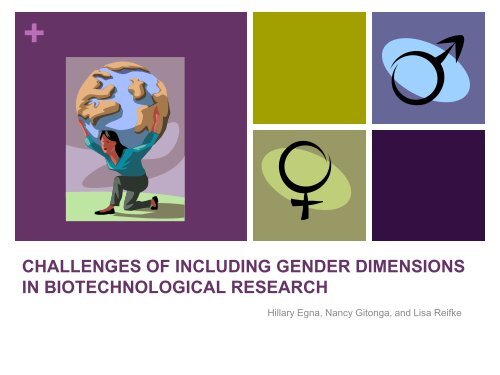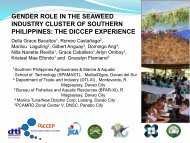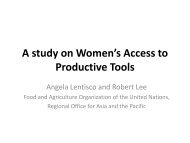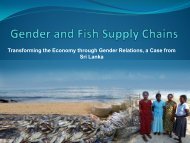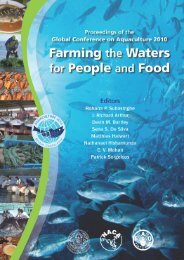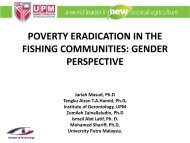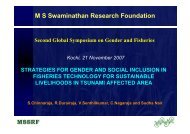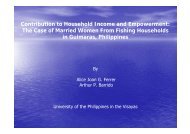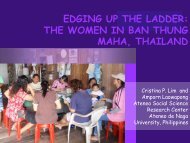Hillary Egna - GENDER IN AQUACULTURE AND FISHERIES
Hillary Egna - GENDER IN AQUACULTURE AND FISHERIES
Hillary Egna - GENDER IN AQUACULTURE AND FISHERIES
Create successful ePaper yourself
Turn your PDF publications into a flip-book with our unique Google optimized e-Paper software.
+<br />
CHALLENGES OF <strong>IN</strong>CLUD<strong>IN</strong>G <strong>GENDER</strong> DIMENSIONS<br />
<strong>IN</strong> BIOTECHNOLOGICAL RESEARCH<br />
<strong>Hillary</strong> <strong>Egna</strong>, Nancy Gitonga, and Lisa Reifke
+ Outline<br />
• Introduction<br />
• Traditional Gender Roles in Aquaculture and Fisheries<br />
• Barriers and Efforts in Gender Issues<br />
• Challenges of Involving Women in Research Positions<br />
• The AquaFish CRSP Training Efforts and Data<br />
• Conclusion/Recommendations
+ Introduction<br />
• Aquaculture and small-scale<br />
fisheries provide a major source<br />
of protein<br />
• An estimated 200 million people<br />
depend on Aquaculture and<br />
Fisheries for employment and<br />
revenue (World Bank 2006)<br />
• As fisheries stocks decline,<br />
aquaculture has become a fast<br />
growing industry<br />
• Women play an integral role in<br />
both fisheries and aquaculture
+ Traditional Gender Roles<br />
in Aquaculture<br />
Men<br />
• Construct ponds<br />
• Manage farms<br />
• Land and farm owners<br />
Women<br />
• Fry catchers<br />
• Laborers<br />
• Processing plants<br />
• Postharvest activities
+ Traditional Gender Roles in Fisheries<br />
Men<br />
• Own most boats and do the<br />
fishing<br />
• Manage large boats<br />
Women<br />
• Post harvest activities:<br />
• Marketing<br />
• Processing<br />
• Manage smaller boats<br />
• Net making and mending
+ Wealth and Power<br />
• Regardless of gender-role differences, wealthier groups of<br />
women and men play dominant roles in the parts of the value<br />
chains where they operate<br />
• Poor members of the chain:<br />
• have weak bargaining power and<br />
• little control over prices paid for goods and services<br />
• more vulnerable to decreases in catch or prices and poor services<br />
because they are unable to accumulate assets<br />
(World Bank et al. 2009)
+ Barriers that Prevent Women’s<br />
Participation<br />
• Time availability and allocation- Women are expected to fulfill<br />
household responsibilities.<br />
• Land ownership and access to water- This is a major barrier<br />
for women who want to own or operate fish farms .<br />
• Credit and labor- Women have less access than men to formal<br />
sources of credit, such as banks or credit unions and rarely<br />
have the collateral required.<br />
• Access to training and extension services- rarely receive<br />
technical advice directly from fisheries officers.<br />
• FAO has determined that women farmers receive only 5% of all<br />
agricultural extension services worldwide despite their increasing<br />
role in food production (UN and FAO 1998)
+ Efforts to Alleviate Gender Issues<br />
• Since the beginning of the International Decade for Women in<br />
1975, efforts have been made to improve the living conditions<br />
of women and to correct the imbalances between men and<br />
women<br />
• Some fisheries projects have contributed to women developing<br />
and exercising leadership and sharing in decision-making<br />
• More is yet to be achieved<br />
• Few women reach the upper echelons of management in<br />
medicine, science, business, fisheries, or agriculture
+ Challenges of Involving Women in<br />
Research—The Leaky Pipeline<br />
• There is a long history of women being underrepresented<br />
in science, engineering, and<br />
technology careers<br />
• Even with global improvements, women in the<br />
sciences are falling through the ‘leaky<br />
pipeline.’<br />
• Pipeline is the system that carries students<br />
from secondary school through graduate<br />
school and into their careers<br />
• There are holes or leaks in the pipeline<br />
• Women leak out more than men<br />
(Blickenstaff 2005)<br />
• Problem is progressive and persistent
+ Equal opportunities do not<br />
necessarily mean equality<br />
• An increase in women graduates has not been accompanied<br />
by associated increase in of women in academic science,<br />
engineering, and technology careers (Bebbington 2002)<br />
• Even in science fields where women were well represented,<br />
such as biology, they aren’t necessarily reaching the top of their<br />
field (Glover 2002)<br />
• Even in developed countries today, women earn $0.82 for<br />
every $1 dollar a male earns in an equivalent job, or about a<br />
15% disparity regarding equal pay for equal work.
+ What are the barriers<br />
• Balancing work and family demands<br />
• Societal gender roles<br />
• Science curricula and pedagogy are more geared<br />
toward men<br />
• Women’s work is often overlooked/undervalued<br />
• Personal values<br />
• The culture of science itself<br />
Adapted from (Bebbington 2002),( Blickenstaff 2005) and (Glover 2002 )
+ The AquaFish CRSP efforts<br />
• The AquaFish CRSP is dedicated to improving gender equity in<br />
the aquaculture and fisheries sectors<br />
• Some of the specific actions taken by the AquaFish CRSP<br />
include:<br />
• Collection and analysis of disaggregated data from projects;<br />
• Promoting the participation of women in education and training<br />
opportunities by setting a 50% benchmark for training women;<br />
• Mandating that all core research projects have a a Gender Strategy;<br />
• Working with each of the core research projects to ensure it has at<br />
least one gender-focused investigation;<br />
• Providing specific extension and technical services for women<br />
producers.
+ CRSP Long-Term Training<br />
• Through equity in training<br />
opportunities, the CRSP has been<br />
able to provide women the tools to<br />
empower themselves<br />
• Long-term training typically took the<br />
form of participation in degree<br />
programs (BS, MS, or PhD) at<br />
higher education institutions, either<br />
in the US or Host Country<br />
• Goal is to empower graduates with<br />
the ability to do research, generate<br />
new knowledge, and solve pressing<br />
problems in their home countries
+ Long-Term Training Data<br />
PD/A and ACRSP (1984-2008)<br />
• 683 students in degree<br />
programs with 36.8% being<br />
women (of those for which data<br />
was recorded)<br />
• Number of women increased<br />
dramatically beginning in about<br />
1999<br />
• Women’s enrollment was<br />
consistently greater than 40%<br />
from 2006-2008<br />
AquaFish CRSP (2006-present)<br />
• 273 students in degree<br />
programs with 130 being<br />
women (47.6%)<br />
• In 2009 and 2010, at least 50%<br />
of the students completing<br />
degrees each year were<br />
women<br />
• When combined with the<br />
previous 3 years of ACRSP<br />
data, it shows that roughly half<br />
(49%) of the graduates in the<br />
past five years were women.
+ Are women graduates entering into<br />
research careers<br />
• We are nearing a 50/50 gender ratio in long-term training but<br />
not seeing the same proportion entering higher positions in<br />
research careers.<br />
• Women in leadership roles in the CRSP:<br />
• 3 out of 24 (12.5%) in the older ACRSP program<br />
• 1 woman out of 7 total US PIs (14.3%) in the AquaFish program<br />
• The CRSP’s Lead Principal Investigator and director is a woman<br />
• 25 women out of 99 personnel (25%) in the 7 core research projects<br />
in the AquaFish CRSP<br />
• 1 of every 2 women degree holders is not yet represented in<br />
the scientific leadership of the Program—might increase as the<br />
women graduates make it further down the pipeline
+ Mainstreaming gender into biotechnological<br />
research programs<br />
• Context: More women in the workforce than any time in history;<br />
With retirements more top leadership positions will be filled by<br />
women; Women still earn less than men for the same work<br />
• What works:<br />
• On going research: Climate studies; Focus groups; Exit interviews<br />
(PCOSW P&T report); Publish regular reports with metrics<br />
• The Process: Do a few things instead of a big agenda; Find and<br />
empower the champions – the others will come along later; Move<br />
forward despite the pushback<br />
• Leadership: Create a climate where inequities can be addressed;<br />
Support identity groups; Model the behavior you want to see; Put<br />
accountability measures in annual reviews<br />
• Programming: Mentoring programs; Leadership academy; On-going<br />
workshops; Women identity groups (The Voices Project)
+ Conclusion<br />
• Future research should include follow up<br />
studies of CRSP women graduates<br />
• Need to bridge the gap between training<br />
and employment, and between<br />
employment and promotion to the<br />
highest levels<br />
• Need qualitative research to look at how<br />
and why these barriers are persisting<br />
• An epistemological approach<br />
(Bebbington 2002) to understand<br />
women’s relationship to science and the<br />
production of scientific knowledge
+ References<br />
• Bebbington, D. (2002), Women in Science, Engineering and Technology: A<br />
Review of The Issues. Higher Education Quarterly, 56: 360–375.<br />
• Blickenstaff, Jacob C. (2005). Women and Science Careers: Leaky Pipeline or<br />
Gender Filter Gender and Education, v17 n4 p369-386.<br />
• Gender in Agriculture Sourcebook, Module 13. Jointly produced by World Bank,<br />
Food and Agriculture Organization, and International Fund 2009.<br />
• Glover, Judith. (2002). Women in Scientific Employment: Current Perspectives<br />
from the UK. Science Studies, Vol. 15(2002) No.1, 29–45.<br />
• U.N. Food and Agriculture Organization (FAO). Women feed the world.<br />
Prepared for World Food Day, 16 October 1998. Rome, Italy.<br />
• World Bank, 2006. Aquaculture Review: Changing the Face of the Waters.<br />
Meeting the Promise and Challenge of Sustainable Aquaculture. Report 36622-<br />
GLB. Washington, DC:IBRD/World Bank.
Funding for this research was provided by<br />
the<br />
+<br />
COLLABORATIVE RESEARCH<br />
SUPPORT PROGRAM<br />
The AquaFish CRSP is funded in part by United States Agency for International<br />
Development (USAID) Cooperative Agreement No. EPP-A-00-06-00012-00<br />
and by US and Host Country partners.<br />
The contents of this presentation do not necessarily represent an official position or policy of the United<br />
States Agency for International Development (USAID). Mention of trade names or commercial products in<br />
this presentation does not constitute endorsement or recommendation for use on the part of USAID or the<br />
AquaFish Collaborative Research Support Program. The accuracy, reliability, and originality of the work<br />
presented are the responsibility of the individual authors.


